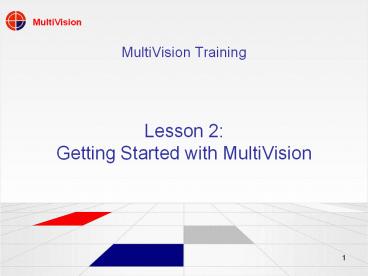Lesson 2: Getting Started with MultiVision PowerPoint PPT Presentation
Title: Lesson 2: Getting Started with MultiVision
1
Lesson 2 Getting Started with MultiVision
- MultiVision Training
2
MultiVision Main Screen
Orthophoto
Menu Bar
Floating Window
Directional Arrow
3
Menu Bar
Toolbar
Status Bar
4
MultiVision Toolbar
Object Transformation Menu Shift Relocate,
Drag Rotate
Directions
Sync button
Terrain
Vertical
Eraser
Corners
3D Modeling
Hand (panning tool)
Polygon Cone
Magnet
Air Type
Full
Buildings
Horizontal
Zoom button
Info
Air
Reset
V. Rect
5
Floating Windows
Floating Window
Floating Window
Floating Window
Floating Window
6
Floating Windows (cont.)
Floating Window Title Bar
Floating Window Toolbar
1
2
3
4
5
6
7
7
Using the Mouse
- The mouse is the main tool for working with
MultiVision. - Most actions can be performed with the left and
right mouse buttons and the scrolling wheel. - Clicking in a window makes it the active window.
8
Using the Mouse (cont.)
Wheel Zooms in and out.
Right click Pans to all sides
Left click Synchronizes all the windows
according to where you click in the active
window. .
9
Other Interaction Tips and Tricks
- Click in a window to make it the active window.
- In Floating Windows
- Move the mouse to the lower bottom edge of the
Floating Window. After a few moments, the
Floating Window toolbar is displayed - Move the mouse out of the Floating Window to
close the toolbar - Move the mouse to the right edge of the Floating
Window. After a few moments, the Layer
Characteristic Panel is displayed. - Move the mouse out of the Floating Window to
close the panel.
10
Making Accurate Measurements is as easy as 1,2,3
- When you select a measurement tool from the
toolbar, a red plumb line appears on screen
together with your cursor. There are three
measurement stages - Stage 1 Indicate the ground point
- Stage 2 Select the starting point to begin
measuring - Stage 3 Select subsequent points according to
the object you are measuring.
11
Making Accurate Measurements
Step 3 On the Plumb Line, Click to mark End
Point
Step 2 On the Plumb Line, Click to mark
Start Point
Step 1 Click to mark Ground Point
12
Finished Measurement
13
Opening a Project
- In the File menu, click Open project.
- In the Open Dialog box, locate and select the
project file you want, then click Open. - The base orthophoto and the related oblique
images are loaded and displayed.
14
(No Transcript)

